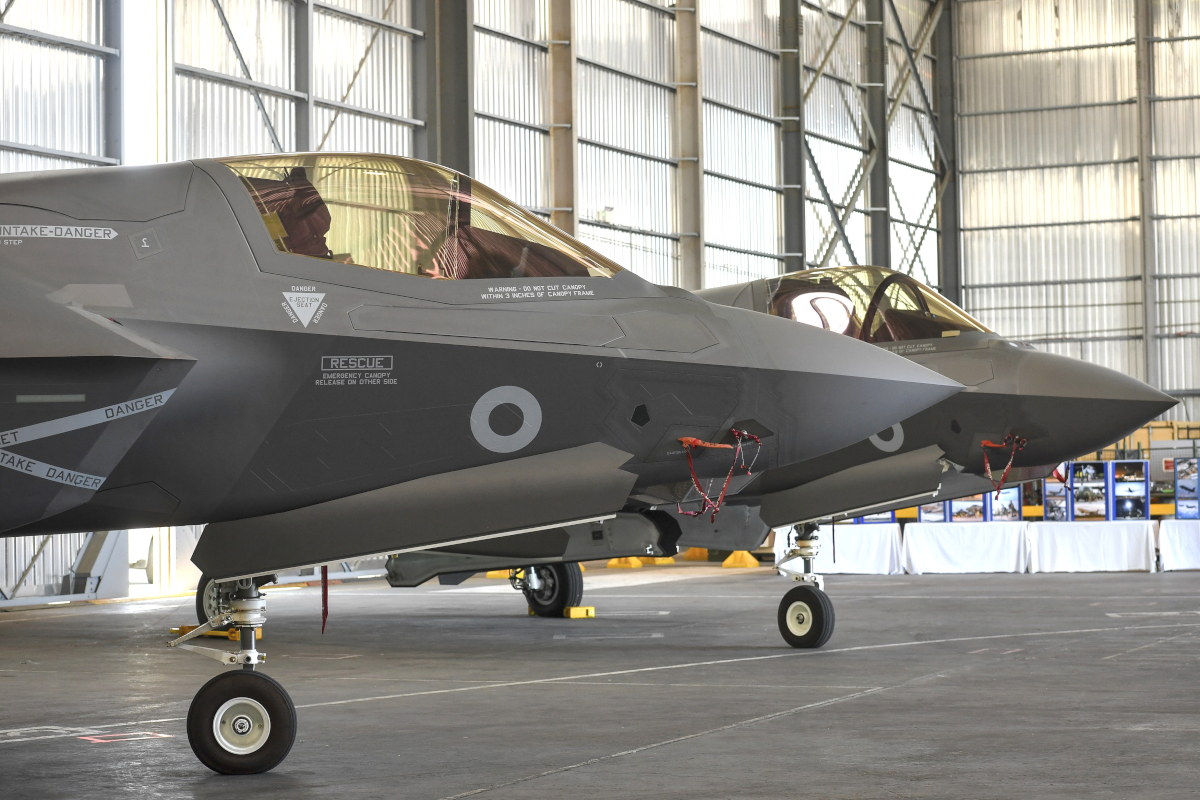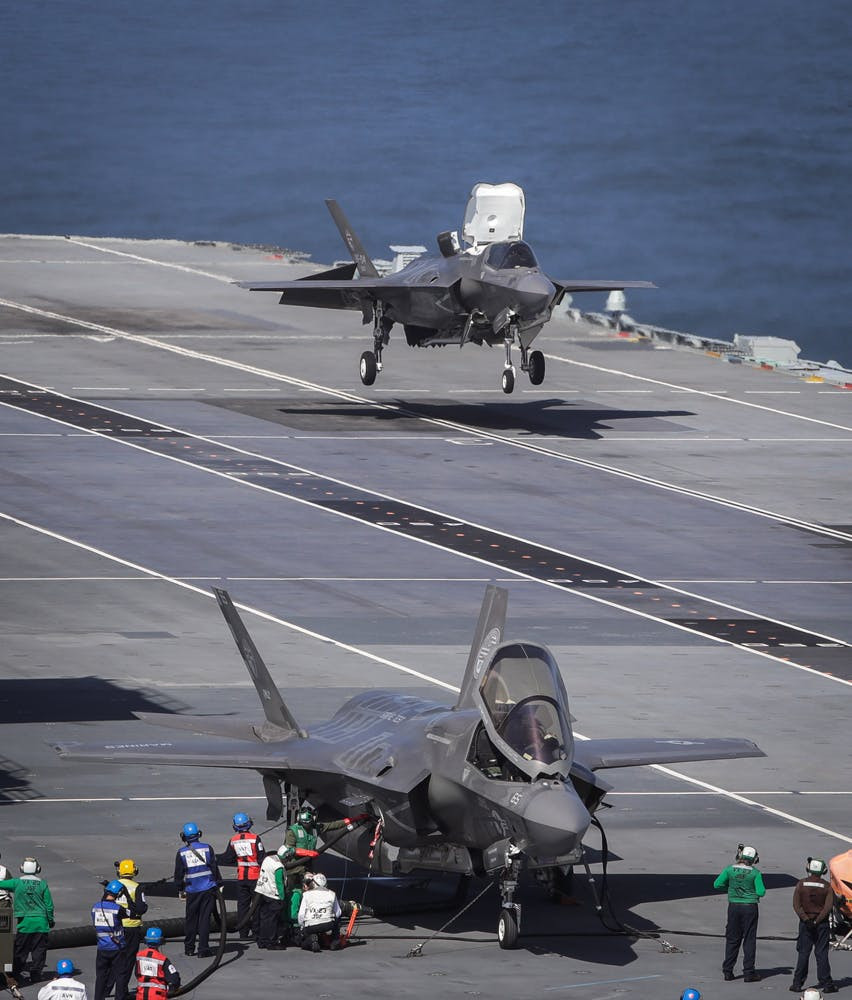The U.K. Ministry of Defense says that Royal Air Force F-35B Joint Strike Fighters have been flying combat patrols over Iraq and Syria for more than a week. This is a major milestone for Britain’s stealthy fighter jets, which only reached initial operational capability in January 2019.
A pair of F-35Bs, also known by their formal nickname Lightning II, from the RAF’s 617 Squadron, flying from RAF Akrotiri in Cyprus in the Mediterranean Sea, conducted the first combat patrol over Syria on June 16, 2019, according to an official statement. The detachment of six Joint Strike Fighters in Cyprus has since flown a combined total of 12 sorties over both Syria and Iraq. The jets have been at Akrotiri since April 2019 and conducted Exercise Lightning Dawn the following month as a workup to actual combat missions. The United Kingdom is now the third country to deploy its F-35s for combat, after Israel and the United States.
The RAF F-35Bs are conducting these “armed overwatch” missions equipped with a pair of 500-pound class Paveway IV dual-mode precision-guided bombs in their internal bays, along with two AIM-120 Advanced Medium-Range Air-to-Air Missiles (AMRAAM). So far, the British jets have not actually engaged any ground targets.
“This first operational mission for the UK’s F-35 Lightning confirms the impressive progress which we have made in introducing this formidable new capability into service,” Air Chief Marshal Sir Stephen Hillier, the RAF’s top officer, said in an official statement. “It is [a] testament to the outstanding abilities of our dedicated and highly trained air and ground crew that 617 Squadron has achieved this important milestone so quickly and so effectively.”
The combat deployment is an important step forward for the United Kingdom, which plans to eventually buy a total fleet of 138 F-35Bs that the RAF and the Royal Navy (RN) will operate together as part of the joint service Lightning Force. Some reports in the past have raised the possibility that some of the future purchases might be of conventional F-35As. At present, the entire force consists of 17 B models split between the 617 Squadron and test and training elements based in the United States.

The RAF expects its components of the Lightning Force to eventually take over many of the roles that the venerable Panavia Tornado had previously filled. The service officially retired those aircraft, nicknamed the Tonka, in March 2019 after almost four decades of operations. Tornadoes had been a regular component of RAF operations in Iraq and Syria right up until the end. Those swing-wing combat jets notably took part in the U.S.-led cruise missile strikes on parts of Syrian dictator Bashar Al Assad’s chemical weapons apparatus on Apr. 14, 2018.
RAF Eurofighter Typhoons have been filling in for the Tornadoes in the meantime and have been steadily increasing their role in the Middle East in recent years, too. But the deployment of the F-35Bs offer important new capabilities, both for British forces still conducting operations against ISIS in Syria and Iraq and in regards to the U.K. military’s overall regional presence.
Most importantly, the Joint Strike Fighters offer sensor fusion and data-sharing capabilities that certainly weren’t found on the now-retired Tornadoes and offer additional functionality over even the systems on its Eurofighters. The F-35B’s Electro-Optical Targeting System (EOTS) provides a non-traditional intelligence, surveillance, and reconnaissance capability and its powerful electronic warfare suite can passively grab information on electronic signatures from radars and other emitters during flight.

This means that the jets might be recording data regarding Syrian, Russian, or Iranian air defenses, as well as ground-based electronic warfare jamming systems, even though 617 Squadron’s mission in the region is focused on fighting ISIS terrorists. This “electronic order of battle” information could be extremely valuable in the event that the United Kingdom joins with the United States or other allies and partners to conduct strikes against higher risk targets, like the chemical weapons sites it destroyed in Syria in April 2018.
The small number of RAF F-35Bs also have the ability to exploit their sensor suite and data links, as well as their stealth features, to serve as leaders and pathfinders for non-stealthy aircraft during larger operations, including those involving coalition partners, if called upon. Underscoring the possibility of future F-35 missions alongside friendly forces, on June 25, 2019, the U.K. Ministry of Defense also revealed that its Joint Strike Fighters had flown a training mission with U.S. and Israeli F-35s. The latter would have been some of Israel’s unique F-35Is, while the former were likely U.S. Air Force F-35As, which deployed to the Middle East for the first time in April 2019.
The sorties over Iraq and Syria will also simply provide valuable experience in a real-world combat environment for the RAF’s first operational F-35B squadron, which will be extremely valuable in the service’s development of tactics, techniques, and procedures on how to operate and employ the still very new aircraft. Despite its obvious operational character, 617 Squadron is itself clearly something of an operational test and evaluation unit.
“The F-35s are the most advanced jets our country has ever possessed and will form the backbone of British air defense for decades to come,” U.K. Defence Secretary Penny Mordaunt said in comments at RAF Akrotiri. “They have passed every test their training has thrown at them with flying colors and their first real operational mission is a significant step into the future for the U.K.”

The squadron is set to embark on board the first-in-class aircraft carrier HMS Queen Elizabeth, along with jets from the dedicated 17 Test and Evaluation Squadron, later in the year to train for shipboard operations. The ability of the UK’s F-35Bs, as well as those from allied countries, to operate from the Queen Elizabeth is an important component of the U.K. Ministry of Defense’s current plans on how to employ that ship.
“This Autumn, our aircraft carrier HMS Queen Elizabeth will return to the East Coast of the United States to conduct Operational Trials with our Lightning Force, taking this 5th generation capability to the next level as they prove their ability to operate from the sea,” Admiral Tony Radakin, the Royal Navy’s top officer, said in a statement. “For decades to come, this exciting new combination of aircraft carriers and F-35B Lightnings will provide a potent, globally deployable carrier strike capability, a powerful conventional deterrent and the centerpiece of our country’s expeditionary forces.”
As it stands now, the RN only expects to receive 42 of the total 138 F-35Bs, 24 of which will be assigned to operational units, with the balance dedicated to training and other tasks. This is simply not enough to provide a full complement of combat aircraft for the Queen Elizabeth. As such, U.S. Marine F-35Bs are already slated to join elements of the Lighting Force on the carrier for her first operational cruise, set to occur in 2021. Jets from 617 Squadron could join them, along with aircraft other RAF and RN units that have stood up by then. The RAF’s 207 Squadron, which will also call RAF Marham home, is the slated to be the next F-35B unit to stand up.

Another F-35 user deploying the jets for actual combat operations is an important demonstration of the type’s suitability for real-world missions, as well. Just recently, new reports emerged highlighting significant ongoing technical issues across all three Joint Strike Fighter variants. Data about U.S. Air Force, Marine, and Navy F-35 fleets have also underscored the high costs and continuing difficulties in operating and maintaining the aircraft, too.
Those issues notwithstanding, the missions over Syria and Iraq show that the United Kingdom is aggressively pushing to begin integrating their F-35Bs into more routine operations, include actual combat deployments. These operational deployments are only likely to keep expanding in size and scope as the Lighting Force continues to grow in the coming years.
Contact the author: joe@thedrive.com
